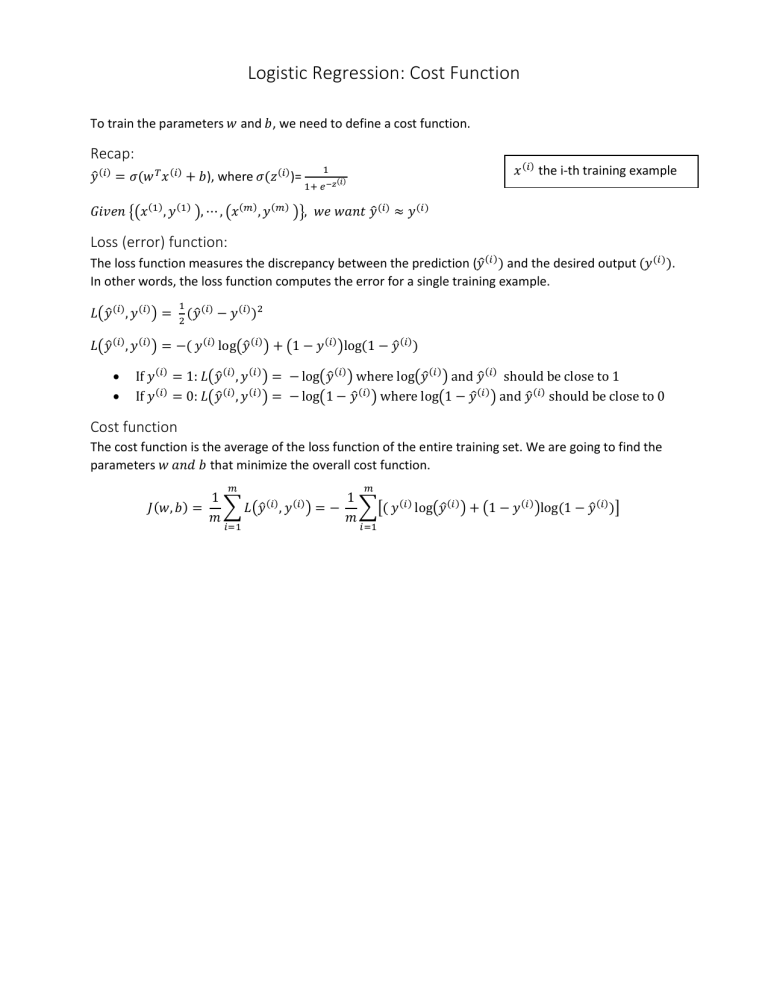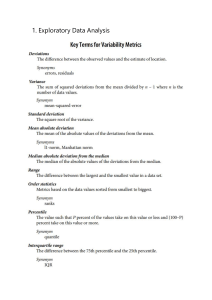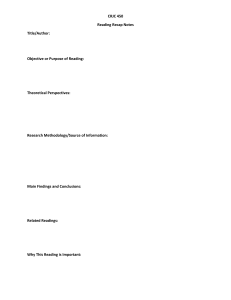
Logistic Regression: Cost Function
To train the parameters 𝑤 and 𝑏, we need to define a cost function.
Recap:
𝑦̂ (𝑖) = 𝜎(𝑤 𝑇 𝑥 (𝑖) + 𝑏), where 𝜎(𝑧 (𝑖) )=
𝑥 (𝑖) the i-th training example
1
(𝑖)
1+ 𝑒 −𝑧
𝐺𝑖𝑣𝑒𝑛 {(𝑥 (1) , 𝑦 (1) ), ⋯ , (𝑥 (𝑚) , 𝑦 (𝑚) )}, 𝑤𝑒 𝑤𝑎𝑛𝑡 𝑦̂ (𝑖) ≈ 𝑦 (𝑖)
Loss (error) function:
The loss function measures the discrepancy between the prediction (𝑦̂ (𝑖) ) and the desired output (𝑦 (𝑖) ).
In other words, the loss function computes the error for a single training example.
𝐿(𝑦̂ (𝑖) , 𝑦 (𝑖) ) =
1
(𝑦̂ (𝑖) − 𝑦 (𝑖) )2
2
𝐿(𝑦̂ (𝑖) , 𝑦 (𝑖) ) = −( 𝑦 (𝑖) log(𝑦̂ (𝑖) ) + (1 − 𝑦 (𝑖) )log(1 − 𝑦̂ (𝑖) )
•
•
If 𝑦 (𝑖) = 1: 𝐿(𝑦̂ (𝑖) , 𝑦 (𝑖) ) = − log(𝑦̂ (𝑖) ) where log(𝑦̂ (𝑖) ) and 𝑦̂ (𝑖) should be close to 1
If 𝑦 (𝑖) = 0: 𝐿(𝑦̂ (𝑖) , 𝑦 (𝑖) ) = − log(1 − 𝑦̂ (𝑖) ) where log(1 − 𝑦̂ (𝑖) ) and 𝑦̂ (𝑖) should be close to 0
Cost function
The cost function is the average of the loss function of the entire training set. We are going to find the
parameters 𝑤 𝑎𝑛𝑑 𝑏 that minimize the overall cost function.
𝑚
𝑚
𝑖=1
𝑖=1
1
1
𝐽(𝑤, 𝑏) =
∑ 𝐿(𝑦̂ (𝑖) , 𝑦 (𝑖) ) = − ∑[( 𝑦 (𝑖) log(𝑦̂ (𝑖) ) + (1 − 𝑦 (𝑖) )log(1 − 𝑦̂ (𝑖) )]
𝑚
𝑚



